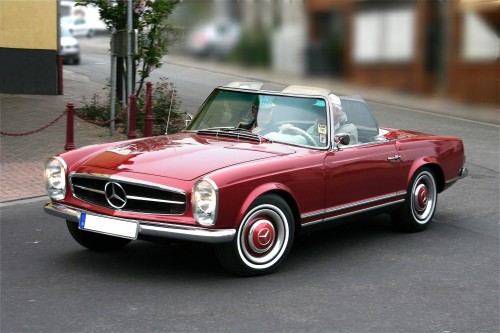Performance Fees are Dead! Long Live Performance Fees!
1955 Mercedes Benz 300SL (a rare aluminum alloy model). Photo Credit: autoblog.com
Earlier this month, Mercer Capital had the pleasure of helping sponsor the Southern Capital Conference, an annual gathering of venture capital and private equity GPs, as well as the LPs who invest with them. Many of the firms and investors were from the Southeast, but there was some representation from the New York-Boston corridor and even a few from Palo Alto. If you believe everything you read about this segment of the investment community, you might expect a fair amount of groaning from the General Partners, with private equity managers under pressure to improve performance, negotiate fees, and increase transparency. The reality was very different.
This particular conference started meeting annually over 30 years ago, when alternative asset funds like PE and VC were a cottage industry that appealed to a small niche of investors. Now this conference is just one of hundreds of alt asset conferences held in the U.S. every year. With all that growth and development there has inevitably been some change in the space, and no doubt there is more to come. I was reflecting on this at the conference when a friend emailed me an article about the 1954 introduction by Mercedes-Benz of the 300SL, best known for distinctive gull wing doors which other car companies have tried to emulate, including Tesla in their Model X.
Today we would call a 300SL an “exotic” car, but in the mid-1950s there was no such thing. One of Mercedes’s distributors, Max Hoffman, suggested the development of a mildly toned-down Grand Prix racer into a fast but comfortable road car. The 300SL was a technological marvel at the time, with a focus on aerodynamics and a tubular space frame that necessitated the famous doors. It was also the first car to feature direct fuel injection, which has only recently become common in passenger vehicles. The Gullwing was the fastest production car at the time. It was also very expensive, similar in price to a contemporary Ferrari and well above the rest of the Mercedes line. In exchange for paying an exorbitant price and tolerating difficult ingress and egress, the 300SL buyer got quite a conversation piece and leading performance. It worked; and in the process Mercedes discovered a whole new product category.
The enduring appeal of private equity and hedge funds seems to mimic the success of the Gullwing. Pay managers more for the hope of better returns, and in exchange accept less transparency and liquidity than one could achieve allocated to registered securities. This sentiment was echoed by the closing speaker at the conference, head of a wealth management firm serving ultra-high net worth families. After giving us what has become a fairly common forecast of much lower returns from equities and bonds, he explained that he’s commonly suggesting private equity to his clients – not just for diversification but also to boost returns. Fees are high, yes, but at least this one wealth manager thought you get what you pay for.
So there was little lament about fee compression or LP demands at the conference. If anything, the concerns voiced by the GP community were that there was too much money chasing too few opportunities. It’s tough to “make your money on the buy” when you get locked in a bidding war with four other firms for the same portfolio company – as the price bids up, the prospective return on investment bids down. The entry prices paid with recent vintage year PE funds portend lower returns going forward – even if a fund avoids unicorn rounds and IPO downrounds.
That said, asset bubbles are relative. With a third of the developed world selling bonds at negative yields, and the U.S. stock market trending up after six straight quarters of earnings declines, bidding for any return at all in the private company space looks, at least on a relative basis, attractive. So fund raising is still alive and well in alt assets, and should be for some time to come.
This isn’t to say, though, that change isn’t on the way. We all know that the tremendous growth of the PE space hasn’t come strictly from wealthy families who can stomach huge return volatility and illiquidity. Much of the growth has been sovereign wealth funds, pensions, endowments, and other institutional class investors that ultimately have to serve the public good. The SEC has gotten interested in the industry, and that only leads to one outcome: more uniformity, more transparency, and more competitive pricing.
So what’s next for performance fees? We have some clues to this mystery in Mercedes’s development of its successor to the Gullwing: the 230SL. Introduced nine years after the original SL, the model was upgraded twice over its nine year product life, and provided a more conventional sports car than the Gullwing. The 230SL wasn’t the fastest production car when it was introduced in 1963; it was powered by a stock inline-six cylinder motor that Mercedes used in other vehicles (the 300SL had a unique engine derived from the German Messerschmitt ME109 fighter aircraft). Nor did the 230SL have as much distinctive bodywork, although the large greenhouse of the hardtop was affectionately nicknamed the “Pagoda-Top.” But despite being a more conventional product, the 230SL was every bit a performance sport car, was cost effective to produce, and was profitable to sell at about two-thirds the sticker price of the original 300SL. Mercedes sold fifteen-times as many Pagoda-Tops as they had Gullwings, in the same number of model years.
So, despite the fact that alternative investment vehicles are inevitably going to endure some homogenization, increased regulation, and some fee compression, there remains a need for the product category. And we think performance fees will endure – at least as long as there is still some performance to fee.

 RIA Valuation Insights
RIA Valuation Insights 







